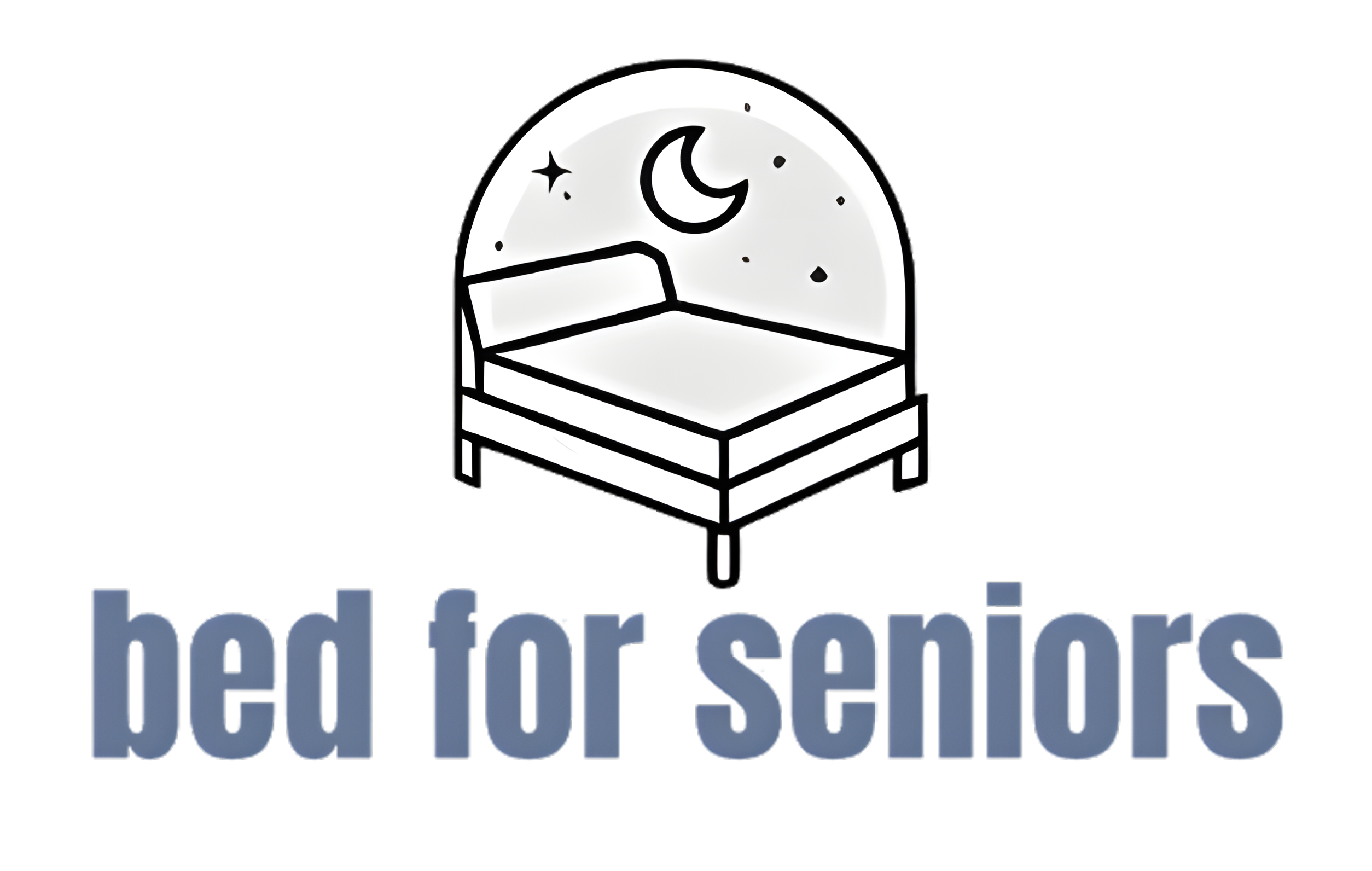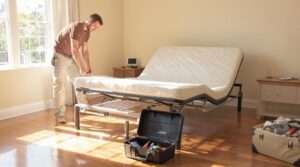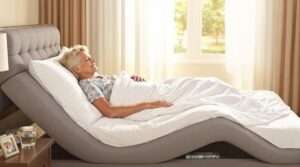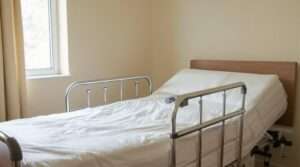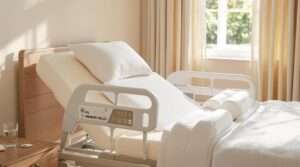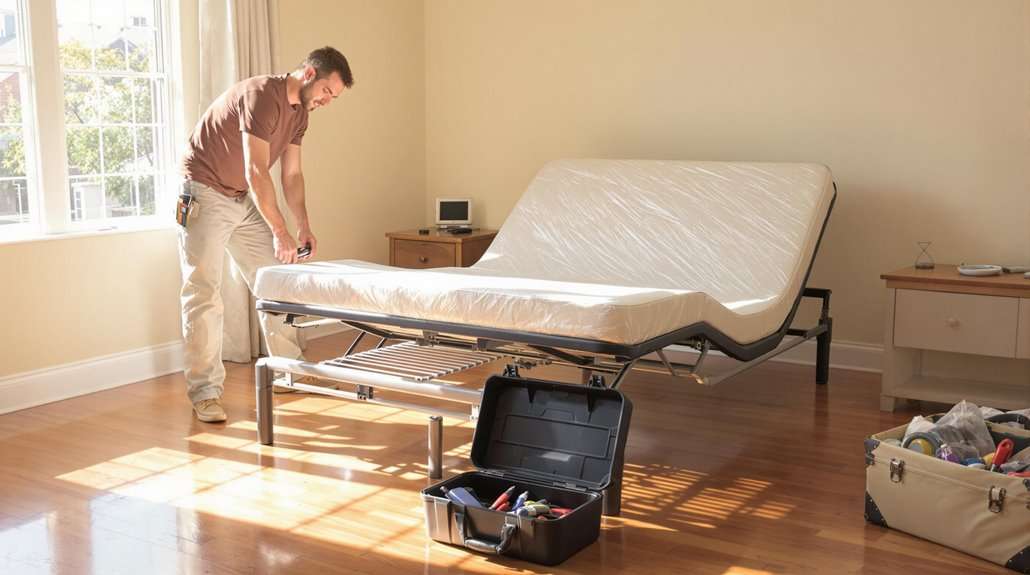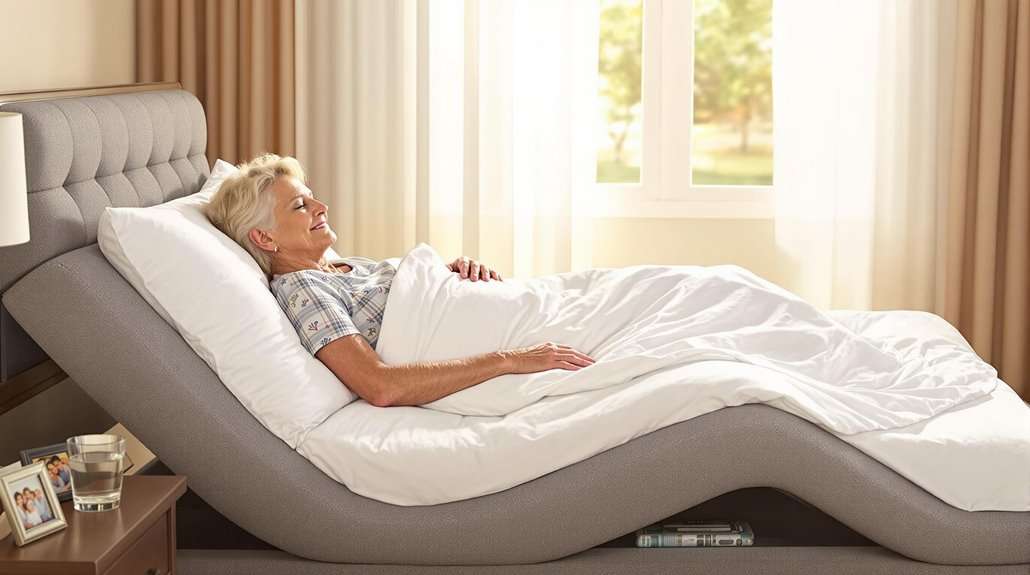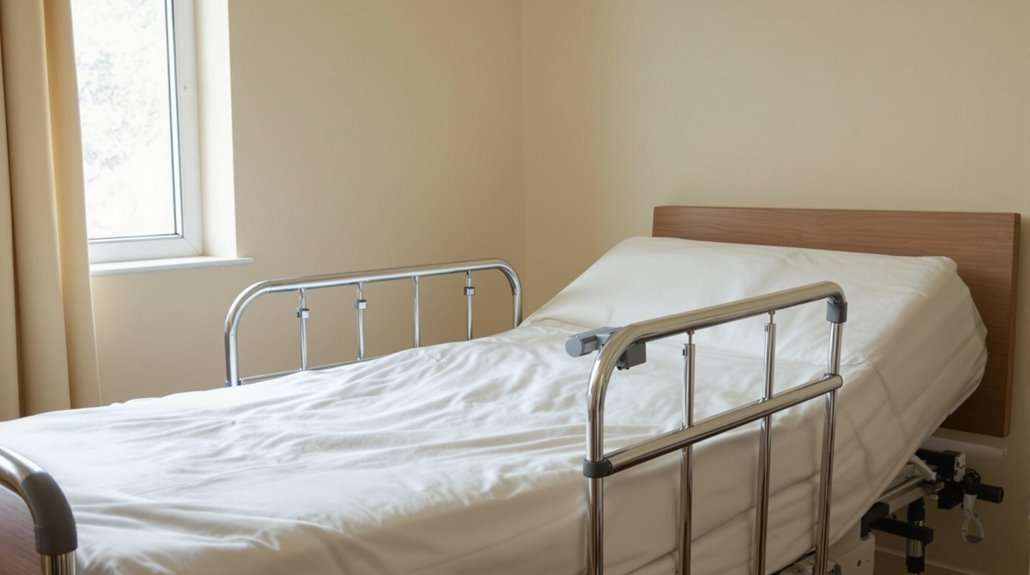Specialized beds play an essential role in elderly care by addressing multiple health and safety concerns. These beds feature adjustable positioning capabilities that help manage chronic pain, prevent pressure sores, and assist with respiratory conditions. Advanced fall prevention systems and secure bed rails greatly reduce injury risks, with statistics showing over 250,000 falls annually among seniors in England and Wales. The beds' automated functions support caregiver efficiency while promoting independent living through customizable features and therapeutic elements. From medical recovery to rehabilitation support, specialized beds enhance both physical well-being and dignity for elderly individuals. Understanding these thorough benefits reveals why specialized beds are becoming an essential investment in senior care.
📋✅
- Specialized beds reduce chronic pain and prevent pressure sores through customizable support settings and therapeutic positioning features.
- Fall prevention systems and secure bed rails significantly decrease injury risks, protecting elderly individuals during sleep and movement.
- Adjustable features enable independent positioning and movement, promoting dignity and reducing reliance on caregivers for daily activities.
- Built-in massage functions and elevated positions help manage health conditions like acid reflux and respiratory problems.
- Remote-controlled operations and height adjustments make caregiving safer and more efficient while reducing workplace injuries.
The Health Impact
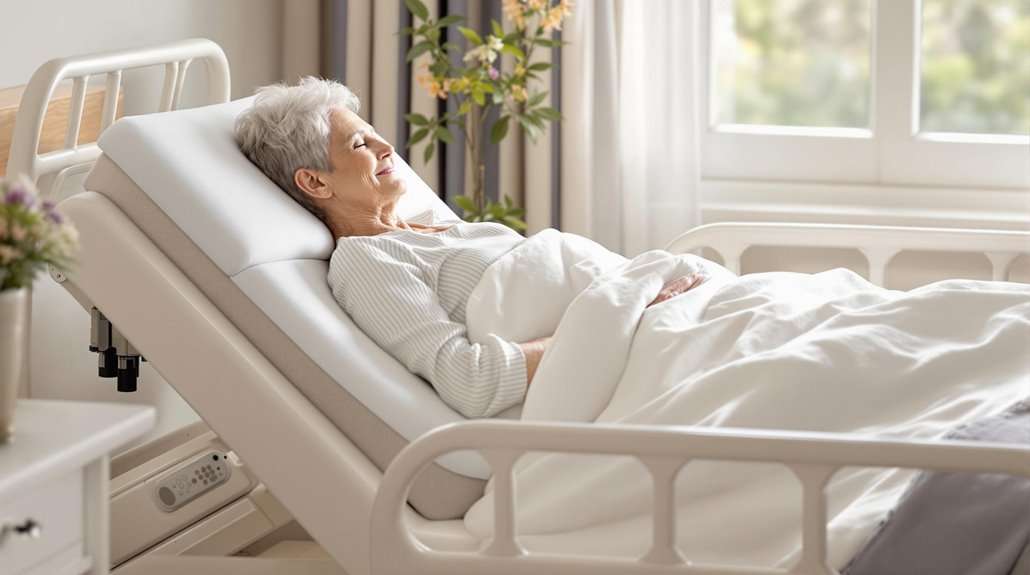
While traditional beds serve basic sleeping needs, specialized adjustable beds offer significant health benefits for elderly individuals facing various medical conditions. These beds deliver extensive pain management solutions by allowing customized positioning that reduces pressure on the spine, joints, and sensitive areas. For those with chronic conditions like arthritis or back pain, the ability to adjust bed positions provides vital relief and support. The box-on-box design makes it easier for elderly individuals to get in and out of bed safely. Remote control operation enables effortless position adjustments without requiring physical exertion.
The medical advantages extend beyond pain management to address multiple health concerns. Elevated positions assist in managing acid reflux and respiratory conditions by keeping airways clear and reducing gastric pressure. Mobility enhancement features enable independent bed adjustments, promoting autonomy for those with limited physical capabilities. The beds' therapeutic design supports cardiac health through strategic positioning that improves circulation and reduces strain on the heart.
Furthermore, these specialized beds contribute to the prevention of pressure sores and enhance sleep quality through customizable support settings. The combination of pressure relief and position adjustability helps maintain proper spinal alignment, while massage functions in some models provide additional therapeutic benefits for musculoskeletal health. This extensive approach to health support makes specialized beds an essential component of elderly care.
Safety for Seniors
Modern specialized beds incorporate critical safety features that address the leading causes of injuries among elderly patients, including advanced fall prevention systems and secure bed rail designs that minimize entrapment risks. With over 250,000 falls annually in England and Wales among the elderly, these specialized beds are crucial for patient safety. Approximately 4,000 emergency visits result from bed rail injuries each year. These beds typically feature adjustable ultra-low positions that reduce fall impact forces and properly engineered side rails that eliminate dangerous gaps between the mattress and rail. Integrated emergency alert systems with fall detection capabilities provide an additional layer of protection, enabling rapid response to potential safety incidents and greatly improving outcomes for elderly patients.
Fall Prevention Systems
Falls represent one of the most important health risks for elderly individuals, with over 14 million older adults reporting falls annually in the United States. With annual costs projected to exceed $101 billion by 2030, implementing effective fall prevention systems is vital for both healthcare facilities and home environments. More than 50% of falls occur in residential settings, making home safety a critical focus for prevention efforts.
Fall risk assessment begins with thorough health evaluations to identify potential contributing factors, including medication side effects, chronic conditions, and environmental hazards. Medical professionals evaluate vision impairment, balance issues, and coordination difficulties to develop targeted intervention strategies. Consistent use of hearing aids can reduce fall risk by up to 50% in seniors with hearing impairment. Evidence-based prevention measures include medication management, physical activity programs to improve strength and balance, and environmental modifications such as adequate lighting and non-slip flooring.
The implementation of medical alert systems provides an additional layer of safety, ensuring immediate response in the event of a fall. These systems, combined with home modification programs and regular exercise routines, greatly reduce fall risk and subsequent injuries. Given that falls are the leading cause of injury-related deaths among adults aged 65 and older, these preventive measures are essential for maintaining independence and quality of life while reducing healthcare costs and hospitalizations.
Secure Bed Rail Design
Securing elderly individuals during bed transfers requires sophisticated bed rail designs that prioritize both safety and accessibility. Modern bed rail materials, particularly high-carbon steel with double crossbeam structures, provide essential stability while supporting weights up to 300 pounds. The three-piece assembly makes setup straightforward for caregivers and family members. These systems incorporate adjustable heights ranging from 19.6 to 25 inches, accommodating various bed configurations and user requirements. With over 3 million seniors treated for fall injuries annually, these safety measures are crucial for prevention.
Installation guidelines emphasize tool-free assembly systems with clear indicating arrows, ensuring proper setup while minimizing entrapment risks. Critical safety features include motion sensor lighting, adjustable frame straps, and ergonomic handles with anti-slip foam padding. The horizontal extension capability of 24.8 to 28.3 inches allows customization for different bed sizes, from Twin to California King.
Safety considerations extend beyond structural integrity to include practical elements such as storage pouches for essential items and proper positioning protocols. Implementation restrictions prohibit usage on specialty beds like toddler, bunk, or inflatable mattresses. The integration of these design elements creates an all-encompassing safety system that addresses both physical support requirements and practical daily needs, ultimately reducing fall risks while maintaining independence for elderly individuals during bed transfers.
Emergency Alert Features
Integrating advanced emergency alert features into specialized beds greatly improves safety protocols for elderly individuals. Alert system integration encompasses various technologies, including bed sensor pads, wireless monitors, and customizable alert mechanisms that detect potential fall risks. These systems provide early warnings to caregivers, enabling swift intervention before accidents occur. Modern bed alarms offer ranges up to 400 feet, ensuring reliable coverage throughout care facilities. The systems feature adjustable sensitivity settings to accommodate different patient needs and minimize false alarms.
Modern specialized beds incorporate sophisticated monitoring devices that detect weight changes and movement patterns, particularly beneficial for seniors with dementia or limited mobility. The technology includes wireless connectivity features, allowing caregivers to receive instant notifications through portable monitors. Proper caregiver training guarantees ideal utilization of these alert systems, including volume adjustment and customization of notification preferences.
These emergency alert features deliver multiple benefits, including reduced fall incidents and enhanced monitoring of wandering behavior. The systems provide peace of mind for caregivers while maintaining seniors' dignity and independence. Professional care facilities particularly benefit from these integrated alert systems, as they enable staff to monitor multiple patients efficiently. The combination of early warning capabilities and immediate notification systems greatly improves response times, ultimately creating a safer environment for elderly individuals requiring specialized care.
Caregiver Support and Benefits
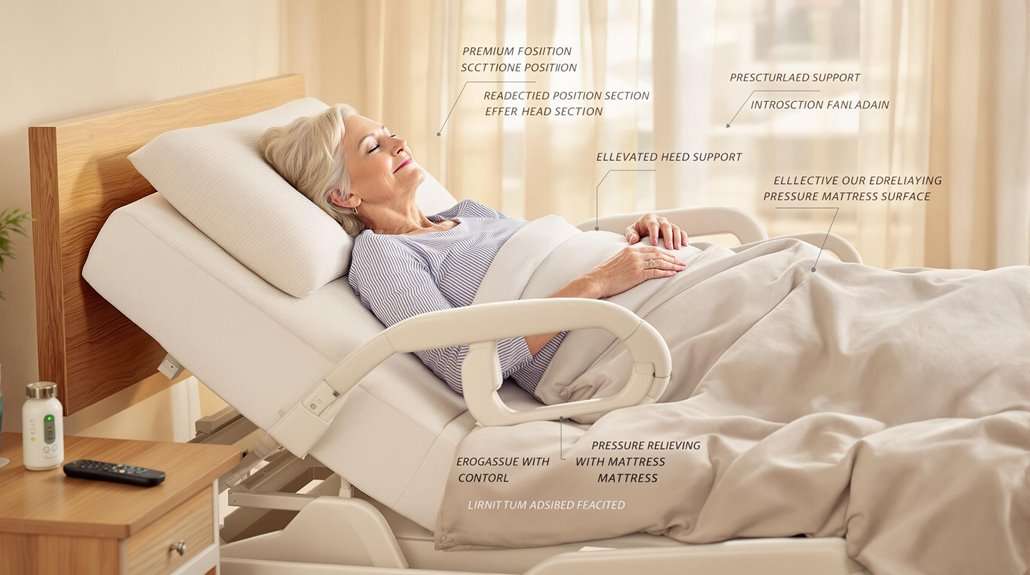
Modern specialized beds offer three vital benefits that greatly improve the caregiving experience for those supporting elderly individuals. First, these beds enhance caregiver efficiency through remote-controlled features that enable precise positioning adjustments without physical strain. The Hi-Low adjustments make it easier for wheelchair transfers and enhance safety. The innovative design helps reduce discomfort during repositioning, making it easier for caregivers to attend to their patients' needs. This technological advancement considerably reduces the physical demands on caregivers while maintaining ideal patient care standards.
Second, specialized beds provide essential support during patient transfers, a critical aspect of caregiver training. The adjustable height settings, combined with compatibility for Hoyer Lift Systems, create a safer environment for both caregivers and patients during transfers. This functionality minimizes the risk of workplace injuries and guarantees consistent care delivery.
Third, these beds contribute to improved long-term care outcomes by supporting preventive health measures. The ability to adjust positions helps prevent pressure ulcers and maintains proper circulation, while enhanced safety features such as rails and backup power systems protect both parties. Additionally, the beds' adaptability to specific patient needs enables caregivers to provide personalized care more effectively. This thorough support system not only enhances daily caregiving tasks but also promotes better health outcomes through improved patient comfort and independence.
Comfort and Quality Sleep
Adjustable beds provide elderly individuals with precise control over their sleeping positions, enabling them to find ideal comfort through customizable head and foot elevation settings. The ability to modify sleeping positions helps redistribute body weight more effectively, minimizing pressure points that can cause discomfort and interrupt sleep. This personalized control proves particularly beneficial for seniors experiencing chronic pain, mobility issues, or specific health conditions that require specialized sleeping positions for symptom management. The specialized mattresses feature enhanced body support that adapts to the unique needs of aging bodies. Research shows that therapeutic massage features are available in many models to provide relief for sore muscles and promote relaxation.
Personalized Sleep Position Control
Four key aspects of personalized sleep position control in specialized elderly beds directly contribute to enhanced comfort and quality sleep. Through adaptive positioning technology, these beds enable precise adjustments of different body segments, allowing seniors to achieve ideal sleep ergonomics tailored to their specific needs.
The ability to independently adjust head and foot sections facilitates targeted pressure relief, particularly beneficial for individuals with chronic pain or circulatory issues. This customization extends to addressing specific medical conditions, such as elevating the upper body to alleviate respiratory difficulties and reduce acid reflux symptoms during sleep. The quiet operation features ensure a peaceful environment conducive to uninterrupted rest.
The beds' sophisticated position control mechanisms enable even weight distribution, minimizing pressure points that can lead to discomfort or bed sores. This feature is particularly valuable for long-term care patients who spend extended periods in bed. In addition, the adjustable features allow caregivers to modify sleeping positions without physically straining themselves, ensuring consistent comfort maintenance throughout the night.
These personalized controls also support independence, as seniors can easily modify their position using electronic controls, promoting autonomy while maintaining safety and comfort in their sleeping environment.
Pressure Point Relief Benefits
Through advanced pressure point relief systems, specialized beds for the elderly deliver extensive comfort and therapeutic benefits that greatly enhance sleep quality. These beds incorporate adjustable support features that distribute body weight evenly across the sleeping surface, markedly reducing pressure on sensitive areas that commonly cause discomfort and pain in older adults.
The customizable nature of these specialized beds allows for precise pressure relief management through various positioning options. By elevating specific body segments, these beds effectively minimize stress on joints and pressure-sensitive areas, helping prevent the development of pressure ulcers and bed sores – particularly essential for individuals with limited mobility. The adjustable support system enables caregivers to modify positions throughout the day, ensuring ideal pressure distribution.
These therapeutic benefits extend beyond basic comfort, directly impacting health outcomes. The even distribution of pressure helps alleviate symptoms associated with chronic conditions such as arthritis and back pain, while simultaneously promoting better circulation. For bedridden patients, specialized pressure-relieving mattresses work in conjunction with the bed's adjustable features to provide thorough pressure point management, greatly reducing the risk of complications associated with prolonged bed rest.
Medical Recovery and Rehabilitation
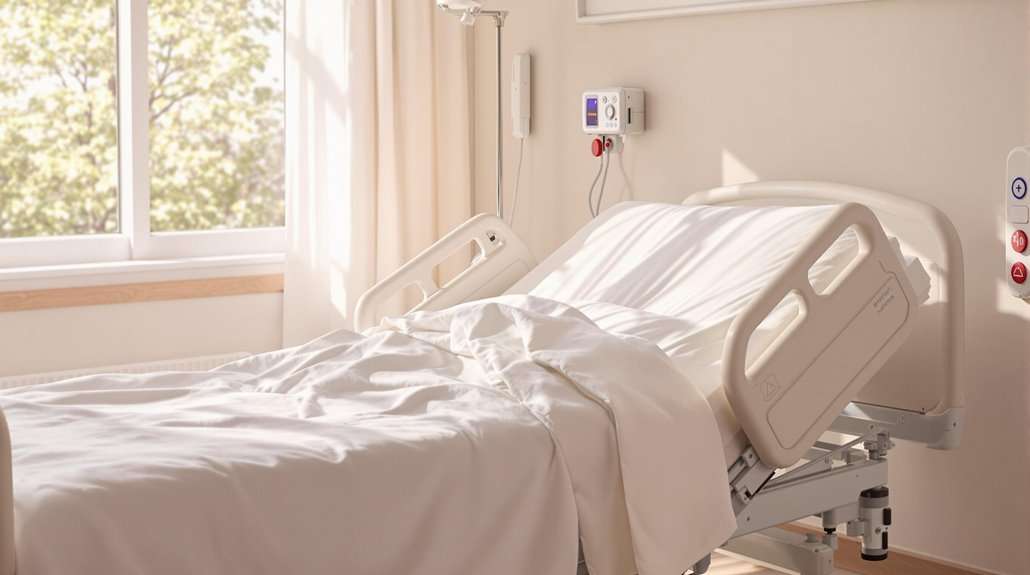
Medical recovery and rehabilitation facilities provide essential specialized care environments where elderly patients can receive extensive therapeutic services while recuperating from surgeries, injuries, or acute medical conditions. These facilities implement thorough rehabilitation strategies through specialized beds designed to support various therapeutic interventions while maintaining patient safety and comfort. Recovery timelines are maximized through 24/7 skilled nursing care and continuous monitoring capabilities.
The specialized beds facilitate multiple forms of therapy, including physical, occupational, and speech therapy, while supporting necessary medical equipment such as IVs and life vests. These beds are specifically engineered to reduce fall risks, enable proper wound care, and maintain infection control protocols. Medicare coverage is available for qualified patients who enter rehabilitation within 30 days of a hospital stay, with costs typically ranging from $8,669 to $9,700 monthly.
The multidisciplinary approach to care in these settings has demonstrated significant benefits for elderly patients, including enhanced mobility, improved functional independence, and better pain management. Combined with dietary counseling and personalized therapeutic activities, these specialized environments promote ideal healing and rehabilitation outcomes.
Independent Living and Dignity
Specialized beds play an essential role in preserving independence and dignity for elderly individuals living at home or in assisted care environments. The incorporation of adjustable features enables seniors to maintain autonomy in their daily routines, fostering independence empowerment through self-directed position changes and bed height adjustments.
These specialized beds contribute notably to dignity preservation by reducing dependence on caregivers for basic mobility needs. The electric controls allow seniors to independently modify their sleeping positions and manage their comfort levels without assistance, promoting self-sufficiency and emotional well-being. Additionally, the beds' customizable features accommodate individual preferences and physical requirements, ensuring that elderly individuals maintain control over their immediate environment.
The integration of safety features, such as side rails and adjustable heights, further supports independent living while minimizing risk. These features provide the confidence necessary for seniors to perform daily activities safely, thereby maintaining their sense of autonomy. The beds' design also facilitates easier transfers and position changes, enabling elderly individuals to preserve their independence while reducing the physical strain on caregivers who provide essential support when needed.
Modern Features and Technology
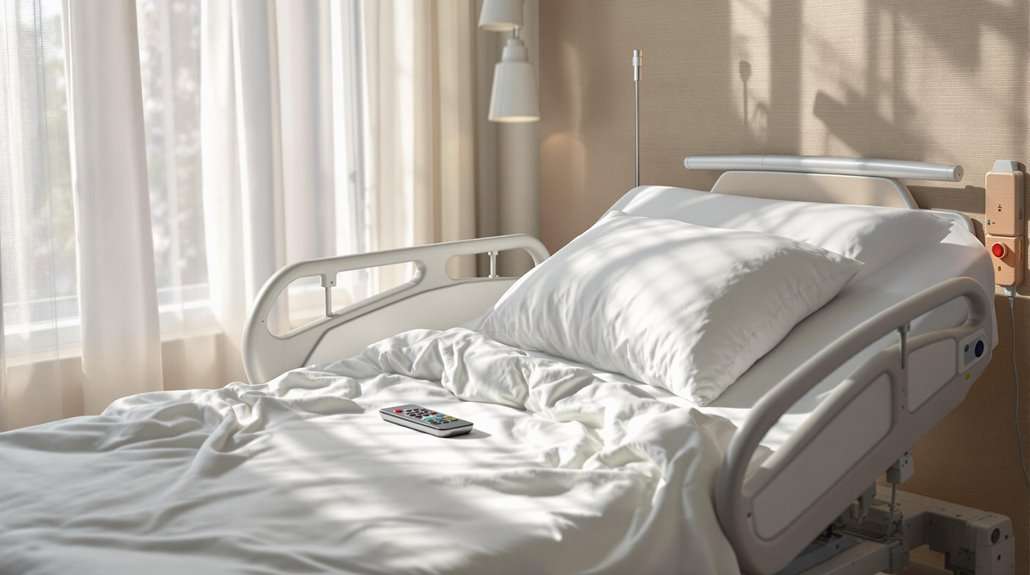
Advanced technological innovations have revolutionized specialized beds for the elderly, incorporating four essential features: automated position control, integrated safety systems, pressure distribution technology, and smart monitoring capabilities.
Modern smart technology enables seamless position adjustments through remote-controlled operations, allowing caregivers and patients to modify bed configurations without physical strain. The adjustable design includes dual controls for personalized comfort settings and variable height adjustments that facilitate safe bed entry and exit. Pressure-relieving mattresses, engineered with specialized materials, effectively prevent bed sores and enhance circulatory function.
These beds integrate extensive safety features, including side rails and sophisticated alarm systems that alert caregivers to potential fall risks. The elevation capabilities serve multiple therapeutic purposes: reducing acid reflux, alleviating respiratory difficulties, and improving blood circulation. Split mattress platforms provide independent inclination options, particularly beneficial for couples with different comfort requirements.
For caregivers, these technological advancements considerably enhance care delivery efficiency. The beds' automated functions reduce physical strain during patient transfers, while smart monitoring systems enable proactive care through real-time alerts and notifications, ensuring ideal patient safety and comfort.
Frequently Asked Questions
How Long Does a Specialized Bed Typically Last Before Needing Replacement?
A specialized bed typically maintains ideal functionality for 7-10 years, with lifespan varying based on usage intensity and maintenance. Key replacement indicators include mechanical failures, compromised structural integrity, and deterioration of essential support components.
Are Specialized Beds Covered by Medicare or Insurance Plans?
Like a safety net for medical needs, specialized beds are typically covered by Medicare when prescribed as medically necessary. Private insurance benefits vary by plan, but many provide coverage with proper documentation and authorization.
Can Regular Mattresses Be Used on Adjustable Bed Frames?
Regular mattresses generally lack bed compatibility with adjustable frames due to their rigid construction. Specialized mattress types designed for adjustable beds are recommended to prevent damage and maintain proper functionality and warranty coverage.
What Maintenance Is Required to Keep Specialized Beds Functioning Properly?
While specialized beds may seem complex, proper bed care is straightforward. Essential maintenance tips include regular cleaning, lubrication of moving parts, electrical component checks, and scheduled professional inspections to guarantee peak functionality and safety.
How Much Electricity Do Powered Adjustable Beds Consume Monthly?
Modern powered adjustable beds are energy efficient, consuming approximately 15 kWh monthly with moderate use. At average utility rates ($0.15/kWh), this translates to roughly $2.25 monthly, making them cost-effective for daily use.
Specialized beds for the elderly represent a critical intersection of healthcare technology and quality of life. Beyond mere comfort, these adaptive systems serve as frontline defenses against bedsores, falls, and mobility challenges. The integration of modern features, from pressure mapping to adjustable positioning, transforms basic furniture into sophisticated medical equipment. Ultimately, specialized beds exemplify the healthcare industry's evolution from reactive treatment to proactive care, ensuring dignity and independence for an aging population.
